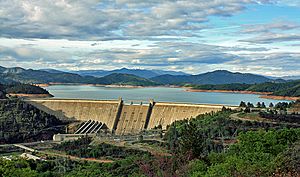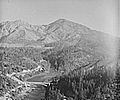Shasta Dam facts for kids
Quick facts for kids Shasta Dam |
|
|---|---|

Shasta Dam in April 2009
|
|
|
Location of Shasta Dam in California
|
|
| Country | United States |
| Location | Shasta County, California |
| Coordinates | 40°43′07″N 122°25′08″W / 40.71861°N 122.41889°W |
| Status | In use |
| Construction began | 1938 |
| Opening date | 1945 |
| Owner(s) | U.S. Bureau of Reclamation |
| Dam and spillways | |
| Type of dam | Concrete gravity |
| Impounds | Sacramento River |
| Height | 602 ft (183 m) |
| Length | 3,460 ft (1,050 m) |
| Width (crest) | 30 ft (9.1 m) |
| Width (base) | 543 ft (166 m) |
| Dam volume | 65,350,000 cu yd (49,960,000 m3) |
| Spillways | 1 |
| Spillway type | River outlets+triple drum gates |
| Spillway capacity | 267,800 cu ft/s (7,580 m3/s) |
| Reservoir | |
| Creates | Shasta Lake |
| Total capacity | 4,552,000 acre⋅ft (5,615 GL) |
| Inactive capacity | 116,000 acre⋅ft (143 GL) |
| Catchment area | 6,665 sq mi (17,260 km2) |
| Surface area | 29,740 acres (12,040 ha) |
| Maximum water depth | 522.5 ft (159.3 m) |
| Power station | |
| Commission date | 1944-1945 |
| Type | Conventional |
| Hydraulic head | 330 ft (100 m) |
| Turbines | 2x 125MW, 3x 142MW |
| Installed capacity | 676 MW 1,976 MW (proposed) |
| Annual generation | 1,935 GWh (2001–2012) |
The Shasta Dam is a huge concrete dam built across the Sacramento River in Northern California. Before it was built, it was sometimes called the Kennett Dam. It stands 602 feet (183 m) tall, making it one of the tallest dams in the United States.
This amazing dam is located at the northern end of the Sacramento Valley. It creates a large body of water called Shasta Lake. This lake is super important for many reasons. It stores water for a long time, helps control floods, and generates hydroelectricity (power from water). It also protects against salty water from the ocean moving too far inland. Shasta Lake is the biggest reservoir in California and can hold about 4,500,000 acre-feet (5,600 GL) of water.
Building a Giant Dam
The idea for Shasta Dam came about as early as 1919. People wanted to save, control, and share water for the Central Valley. This area is California's main farming region, and it needs a lot of water to grow crops.
In the 1930s, the state of California first approved the dam project. However, the Great Depression hit, and there wasn't enough money to start building. So, the project was taken over by the federal government's United States Bureau of Reclamation. It became a big public works project, which meant it created many jobs.
Construction officially began in 1937, with Frank Crowe as the chief engineer. Building the dam provided thousands of much-needed jobs during a tough economic time. The workers finished the dam in 1945, which was twenty-six months (over two years!) ahead of schedule. When it was done, Shasta Dam was the second-tallest dam in the U.S., right after Hoover Dam. It was seen as one of the greatest engineering achievements of its time.
Why Shasta Dam is Important
Even before it was officially opened, Shasta Dam played a big role in World War II. It produced electricity that powered factories across California, helping the war effort. Today, it's still a key part of how California manages its water.
However, building the dam also brought big changes to the environment and wildlife of the Sacramento River. It also flooded lands that were very important to Native American tribes. In recent years, people have been discussing whether to make the dam even taller. This would allow it to store more water and create more electricity.
Images for kids
-
The Pit River Valley, now under Shasta Lake, in 1941. The bridge visible near the bottom once carried U.S. Route 99 before it was replaced by the Pit River Bridge (from the deck of which this photo was taken).
-
The Pit River Bridge, which was built to carry Interstate 5 and the Southern Pacific Railroad over Shasta

















